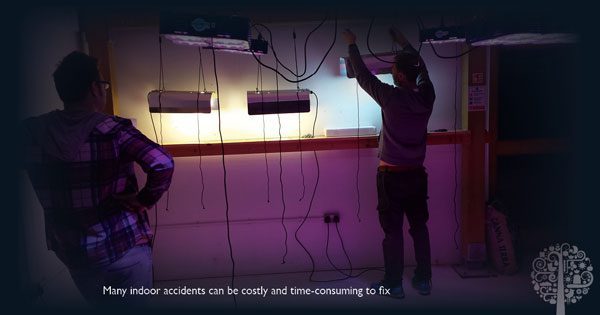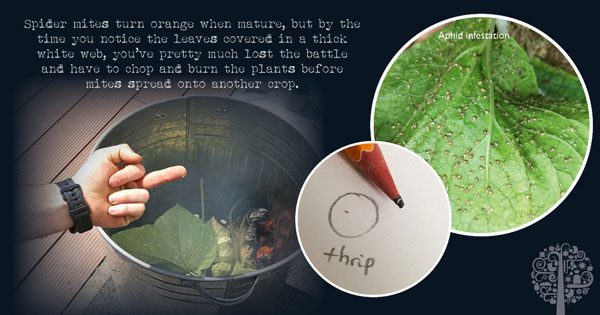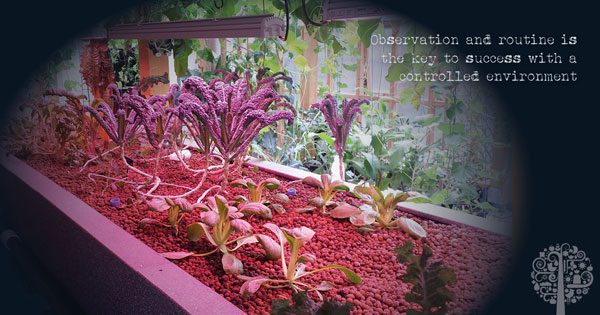As you’re heading to your grow room with a long list of tasks to tackle, you walk through the door, and splat! You look down at your wet shoe and know the shine on the floor isn’t because someone polished it while you were away; you have a three-inch-deep pool at your feet. Then, you notice the delicate hum of the tap and the trickle of water coming down the side of your water tank. Someone’s left the faucet running all night, and someone’s in trouble.
Growing Disasters
This delightful scene is just one of the indoor growing disasters that no one wants to ever deal with, but unfortunately, they happen more often than they should. Growing indoors should make for the most controlled environment possible. Still, when you’re busy dealing with your plants, multitasking between water tanks, mixing nutrients, and then suddenly the phone rings, the running tap escapes your thoughts like a sweet dream smashed by the alarm clock’s ring.

Indoor growing is a lot more complicated than outdoor simply because there are more variables to consider, technology included! While there are dozens of incredibly skilled growers in this issue writing about the success stories and top tips from their grow rooms, I’ll take you on a mini horror trip instead, which will hopefully help you avoid some rookie mistakes.
The Buzz
Unlike the great outdoors where a plant’s growing cycle is dictated by natural daylight hours, indoors, we try to imitate various seasons with lights and heat. Take aubergines as an example. We can start the seeds in heated propagators when it’s still freezing outside, then by the time cold April showers whip the daffodils outside, our seedlings are well-established and have started to set their flowers. We’re delighted to see a bounty of purple petals but then are horrified to see them fall to the floor a few days later. At this point, you realize that not all plants are self-pollinating.
Fun fact: If you don’t release bees into your indoor grow room, the best time to hand-pollinate an aubergine is between 6 am-11 am. When the flower closes and doesn’t fall off, you’re heading for success.
Act Before Problems Arise
One of the worst things to happen in a grow room is missing the early signs of a pest infestation. When you notice a tiny web around the leaves with two-spotted mites, it’s probably time to bring the napalm out of the chemical cupboard. At this point, make a mental note to your future self: get the predators before you have the problem. Have a sachet of biological pest control ready when plants are young; this way, any pest entering the grow room will have an unpleasant surprise waiting for them. Unfortunately, many critters are hard to spot. The spider mites are light green when young, almost translucent and invisible to an untrained eye. They turn orange when mature, but by the time you notice the leaves covered in a thick white web, you’ve pretty much lost the battle and have to chop and burn the plants before mites spread onto another crop.

The same applies to other prevalent indoor pests. Before you notice aphids, you may see white parts of their body shed on a leaf, a sticky sap, or black mold on the leaves. Get some parasitic wasps when your plants are still babies and let them patrol the grow room in case an aphid dares enter on your clothing. If the indoor grow is connected to a food hub, consider using one of those UV lamps that attract insects for a quick electric shock and death. Turn them off before you release the wasps; otherwise, you might find yourself wondering why they aren’t working!
Establish A Daily Routine
Observation and routine is the key to success with a controlled environment. As soon as you notice discoloration or a leaf curl, go and check all your water tanks to see if your EC and pH are in order, especially if you’re not the only one looking after the plants in your team.

In my early growing days, I could not understand how, within a couple of days, a plant could go from healthy to one that was drooping and curling. When I began checking the parameters, I noticed that every water tank had different (and out of scale) EC and pH readings. I learned to double-check my students’ work just in case mistakes were made. If you love technology, invest in a monitoring system like a Raspberry Pi, where all the probes show real-time readings. However, don’t put all of your trust in them; regularly check and calibrate tools, as they may be off the scale. Precision is crucial to indoor growing. Check your system for any leaks, kinks, blockages, sediments, and so on. Verify that lamps are mounted safely and that the plant support system is reliable. Hopefully, the only thing smashed on the floor will be an odd tomato redefining itself as ketchup.
Know Your Animals
Many indoor accidents can be costly and time-consuming to fix, but there is nothing worse than knowing that the mistakes made caused an injury or even the death of an innocent animal. When incorporating an aquaponics system into the indoor garden, take extreme precautions as to what chemicals are used and how well the equipment is working. Even the simple soap spray for aphid control can cause severe damage to aquatic life. From the pump and drainage system to the heaters and oxygen pumps, there is a lot that can go wrong in a very short time, so regular observation is critical.
For example, one winter morning, I noticed the tilapia fish we kept weren’t very keen on their breakfast, which was odd, but I assumed they didn’t have the appetite. When none of them came up for food at the second feed, I began to worry. All the pumps seemed to work fine, and the water quality was good, but when I touched the heater, I discovered it was stone cold. It seemed to have failed at night, and the water temperature was far too low for the tropical fish to be comfortable. A quick run to the local hydro store and the purchase of all of the small heaters they had in stock raised the temperature enough for the fish to perk up, but trying to heat a ten thousand litre fish tank in the dead of an English winter is not fun. My advice is to purchase a spare heater before this happens to you. There were no casualties, but I had heard a horror story from another grower whose pump system was blocked when nobody was around. Water overflowed the tank, and the team had a very unpleasant surprise in the morning that resulted in the loss of all their fish.
Harvest Time
Growing is so much fun, but after harvest, make sure the produce is adequately preserved, so the fruits of your labor aren’t wasted. Research correct drying temperatures for herbs; I can tell you from experience that drying in full sun to speed things up is a no-go! Master the art of preserving, drying, or even pickling some of those gherkins so you can enjoy them for a long time.

The key to avoiding many mistakes in a controlled environment is almost always prior knowledge. By the time you notice a problem you’ve never heard about before, it’s often too late to do anything about it. Research the subject at hand to have half a chance of spotting problems before they happen. Read about the techniques, equipment, varieties of plants and their needs, and use the great vault of knowledge growers around the world have created in many magazines, books, YouTube videos, and podcasts. Most importantly, establish a routine in your grow, no matter what its size, so you can reap the benefits for months to come.